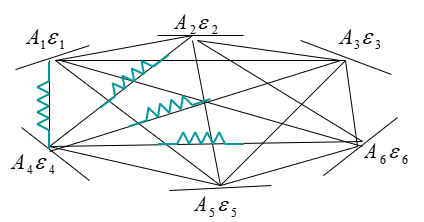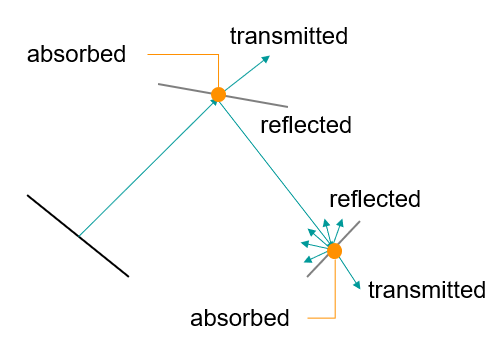Radiation exchange
Thermal radiation is a heat transfer due to electromagnetic radiation emitted by the surface of bodies due to their temperature.
Radiation is not solely a surface phenomenon. However, nearly all thermal radiation heat transfer is concerned with surface-to-surface interactions. In the infrared spectrum, most surfaces are optically opaque, not transparent. Additionally, thermal radiation does not require the presence of a material or medium for transmission.
The power emitted by a surface at temperature T is:
where:
- Aj is the surface area of element j.
- ε is the emissivity and is defined according to the model's optical properties.
- σT4 terms make the emitted radiative heat dependent on temperature.
To determine the radiative heat exchange in a radiative enclosure, which consists of a series of absorbing, emitting, and reflecting surfaces that interact with each other, the thermal solver solves the radiative heat balance between all surface elements. This process assumes that instantaneous thermal equilibrium is reached, meaning that the temperatures of the surfaces are stable and do not change over time during the calculation. This assumption allows the solver to accurately compute the net radiative heat exchange between the surfaces.
There are two primary approaches to compute radiative heat exchange:
- Conductance-based method
- This method uses radiative conductance to calculate the radiative heat exchange
between surfaces. It involves solving the radiative heat balance equations using
these conductance values, which represent the fraction of radiation leaving one
surface that reaches another surface The fraction of the total energy emitted
from one surface element that arrives directly at another surface element is
called a view factor.

- Ray-tracing method
- This method involves tracing rays of radiation from one surface to another to
determine the paths and interactions of the radiation. It accounts for
reflections, absorptions, and transmissions along the way, providing a detailed
and accurate calculation of radiative heat exchange, especially in complex
geometries. Many light rays are generated from each surface, and each ray is
tracked individually. Every time a ray collides with a surface, the portions
that are reflected, transmitted, and absorbed are calculated. The tracking
continues until the ray is extinguished, meaning its energy content falls below
a small threshold (e.g. 1%).

